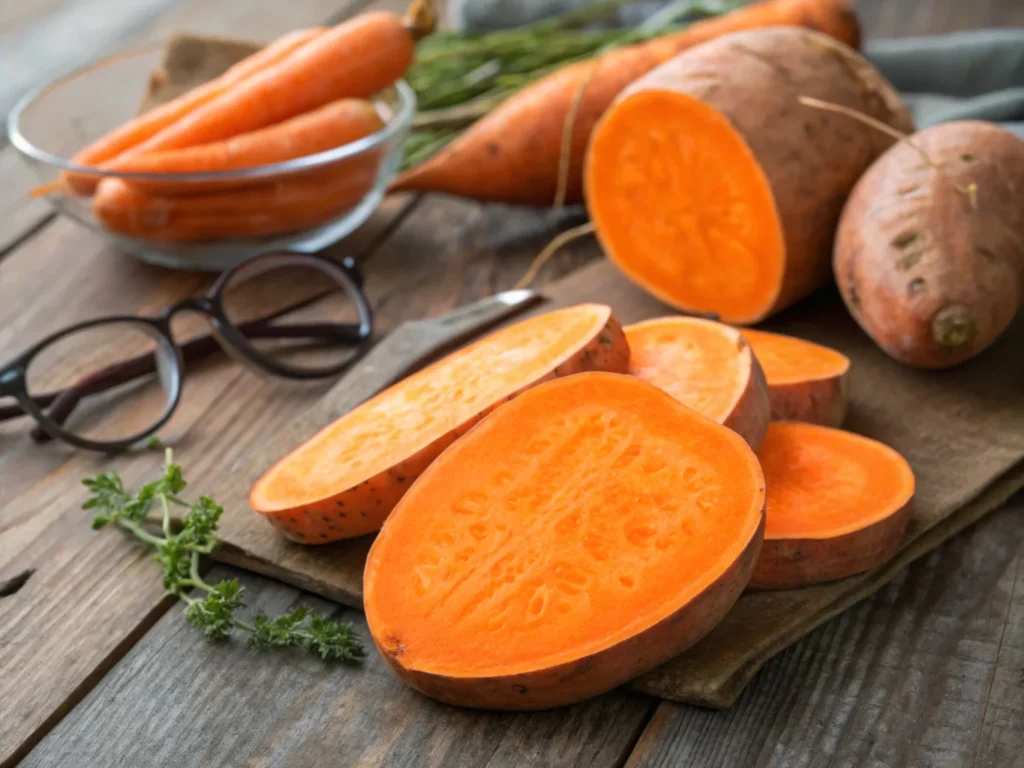Introduction to Sweet Potatoes: Finding the Healthiest Color
Sweet potatoes come in a variety of colors—orange, purple, white, and yellow—but which color sweet potato is healthiest? Each type offers unique nutrients and health benefits that make it stand out. From the rich beta-carotene in orange sweet potatoes to the powerful antioxidants in purple ones, these vibrant tubers can support different aspects of your health. To help you decide which sweet potato is best for you, let’s dive into their nutrient profiles, health benefits, and how they compare. By the end, you’ll know which color deserves a spot on your plate!
Why Sweet Potatoes Deserve the Spotlight
Sweet potatoes are more than just a starchy side dish; they are a nutrient-dense food packed with essential vitamins, minerals, and antioxidants. Their natural sweetness makes them a favorite for both savory and sweet dishes, but their real appeal lies in the health benefits they bring to the table.
- Rich in Fiber: Sweet potatoes aid digestion and improve gut health.
- Loaded with Vitamins: High levels of vitamin A, C, and B6 make them excellent for immunity, skin, and energy production.
- Antioxidant Powerhouses: Depending on the variety, sweet potatoes offer varying levels of antioxidants, which combat oxidative stress and inflammation.
Understanding the nutritional differences between colors can help you make smarter food choices.
Orange Sweet Potatoes: The Beta-Carotene Champion
Orange sweet potatoes are perhaps the most popular and widely recognized variety, often associated with Thanksgiving casseroles and hearty side dishes. Their bright orange hue comes from beta-carotene, a plant pigment that converts to vitamin A in the body. Here’s why they pack a nutritional punch:

Nutritional Highlights
- High in Beta-Carotene: Just one medium orange sweet potato can provide over 200% of your daily vitamin A needs. This nutrient is essential for maintaining good vision, immune function, and skin health.
- Rich in Fiber: With about 4 grams of fiber per medium potato, they help regulate digestion and support gut health.
- Low Glycemic Index (GI): Despite being naturally sweet, orange sweet potatoes have a relatively low GI, meaning they release sugar slowly and don’t cause rapid spikes in blood sugar levels.
Health Benefits
- Eye Health: Thanks to their vitamin A content, orange sweet potatoes can help prevent conditions like night blindness and age-related macular degeneration.
- Immune Support: Vitamin A plays a crucial role in boosting immune defenses, making these sweet potatoes a great choice during cold and flu season.
- Heart Health: The combination of potassium and fiber supports healthy blood pressure and cholesterol levels.
How to Use Them
Orange sweet potatoes are versatile and easy to prepare. Roast them for a caramelized flavor, mash them as a healthier alternative to regular potatoes, or slice them into fries for a crispy treat. Adding a little fat, like olive oil, can improve the absorption of beta-carotene.
If you’re looking for a nutrient-dense food to brighten your meals, orange sweet potatoes are a top contender. Their combination of essential vitamins, minerals, and natural sweetness makes them a healthy and delicious choice.
Purple Sweet Potatoes: Antioxidant Powerhouses
Purple sweet potatoes are visually stunning, but their benefits go far beyond their vibrant color. Their deep purple hue comes from anthocyanins, powerful antioxidants that are also found in foods like blueberries and red cabbage. These unique compounds make purple sweet potatoes stand out as a nutrient powerhouse.

Nutritional Highlights
- High in Anthocyanins: These antioxidants are known for their role in fighting free radicals, reducing inflammation, and supporting overall health.
- Rich in Fiber: Like their orange counterparts, purple sweet potatoes contain about 4 grams of fiber per medium potato, aiding digestion and promoting a healthy gut microbiome.
- Lower Calories: Purple sweet potatoes are slightly lower in calories than some other varieties, making them a great option for weight-conscious eaters.
Health Benefits
- Anti-Inflammatory Properties: Anthocyanins help combat inflammation in the body, which is linked to chronic diseases like heart disease and diabetes.
- Brain Health: Studies suggest that anthocyanins may improve cognitive function and reduce the risk of neurodegenerative diseases like Alzheimer’s.
- Cancer Prevention Potential: Research indicates that anthocyanins may help inhibit the growth of certain cancer cells by neutralizing oxidative stress.
How to Use Them
Purple sweet potatoes have a dense, creamy texture and slightly nutty flavor. They work well in both sweet and savory dishes. Bake them whole, puree them for soups, or use them to make vibrant desserts like purple sweet potato pie or pudding. Their natural color can make any dish stand out on the table.
If you’re seeking a variety of sweet potato with maximum antioxidant power, the purple sweet potato is an excellent choice. Its health benefits, paired with its striking appearance, make it a star ingredient in any diet.
White Sweet Potatoes: A Mild and Nutritious Option
White sweet potatoes may not be as colorful as their orange or purple counterparts, but they still offer plenty of health benefits. With a lighter taste and texture, they’re a great choice for those who prefer a milder flavor. While they have less beta-carotene and antioxidants, they make up for it with other nutrients and culinary versatility.

Nutritional Highlights
- Lower in Sugar: White sweet potatoes have a more subtle sweetness, which translates to slightly lower natural sugar content compared to orange varieties.
- Rich in Potassium: They provide a good dose of potassium, which helps regulate blood pressure and supports muscle function.
- High in Vitamin C: A medium white sweet potato offers about 20% of your daily vitamin C needs, boosting your immune system and promoting collagen production.
Health Benefits
- Supports Energy Levels: With their balanced mix of carbohydrates and potassium, white sweet potatoes are ideal for fueling workouts or staying energized throughout the day.
- Promotes Healthy Digestion: The fiber in white sweet potatoes helps keep your digestive system running smoothly and can aid in preventing constipation.
- Gentle on Sensitive Stomachs: Their mild flavor and lower sugar content make them a good option for people with sensitive stomachs or those managing blood sugar levels.
How to Use Them
White sweet potatoes are a versatile option in the kitchen. Their starchy texture makes them a great substitute for regular potatoes in dishes like mashed potatoes or potato salads. They also pair well with savory herbs and spices, making them a fantastic addition to roasted vegetable medleys or soups.
For anyone looking for a lighter, less sweet version of this beloved root vegetable, white sweet potatoes are an underrated but valuable choice. Their neutral flavor makes them adaptable for a wide range of dishes, allowing them to shine in any meal.
Yellow Sweet Potatoes: A Finest Choice for Health
Yellow sweet potatoes sit somewhere between orange and white varieties in both flavor and nutrition. They’re slightly sweeter than white sweet potatoes but milder than orange ones, offering a balance of nutrients that make them a versatile choice for many diets.

Nutritional Highlights
- Moderate Beta-Carotene: While they don’t match the orange sweet potato’s beta-carotene levels, yellow sweet potatoes still offer a decent amount, contributing to eye health and immune function.
- High in Vitamin C: A single yellow sweet potato can provide a significant portion of your daily vitamin C needs, helping support collagen production and immune health.
- Rich in Fiber: With about 3–4 grams of fiber per medium potato, yellow sweet potatoes promote healthy digestion and can help regulate blood sugar levels.
Health Benefits
- Boosts Skin Health: The vitamin C in yellow sweet potatoes aids in collagen synthesis, which supports healthy, glowing skin and reduces signs of aging.
- Supports Immune Function: Both vitamin C and beta-carotene help strengthen the immune system, making yellow sweet potatoes a great choice during flu season.
- Aids Digestion: Their fiber content helps maintain a healthy gut and can reduce the risk of digestive issues like constipation.
How to Use Them
Yellow sweet potatoes have a creamy, moist texture that works well in baked goods like muffins, pancakes, or pies. They’re also delicious when baked, mashed, or roasted. Their natural sweetness makes them a good candidate for breakfast dishes like sweet potato hash or as a topping for oatmeal.
If you’re looking for a middle ground between the bold flavor of orange sweet potatoes and the mildness of white ones, yellow sweet potatoes offer the best of both worlds. They bring solid nutritional value and a delicious, balanced taste to the table.
Cooking Methods and Nutritional Impact: Do They Affect Which Color Sweet Potato is Healthiest?
Here are some simple ways to enjoy sweet potatoes, no matter the color:
- Roast them: Toss them in olive oil, sprinkle with salt, and bake until crispy.
- Mash them: Add a little butter and cinnamon for a cozy side dish.
- Make fries: Sweet potato fries are a healthier alternative to regular fries.
- Bake them whole: Top with Greek yogurt, a drizzle of honey, and a handful of nuts for a filling snack.
The Bottom Line
There’s no “bad” choice when it comes to sweet potatoes. Orange and purple varieties edge out the others in terms of antioxidants, but white, yellow, and red have their own perks. At the end of the day, the healthiest sweet potato is the one you’ll actually eat and enjoy.
So go ahead, toss some sweet potatoes into your cart (bonus points for trying a new color), and treat your body to some colorful, nutrient-packed goodness.
Seasonal Eating with Sweet Potatoes: Which Color Sweet Potato is Healthiest Year-Round?
Sweet potatoes shine during the fall and winter but can be enjoyed year-round in different ways:
- Fall & Winter: Perfect for cozy dishes like soups, casseroles, and pies.
- Spring & Summer: Toss them into salads, grill them for a smoky flavor, or use them in a veggie medley.
Buying locally sourced sweet potatoes during their peak season ensures better taste, freshness, and nutritional value.
Environmental Impact of Sweet Potato Farming: Which Color Sweet Potato is Healthiest for Sustainability?
The sustainability of sweet potato farming makes it a more environmentally friendly opSweet potatoes are not just good for your body—they’re good for the planet too. Here’s why they’re an eco-friendly choice:
- Low Resource Use: They thrive in various climates with minimal water and fertilizer.
- Improved Soil Health: Their roots prevent erosion and enhance soil quality.
- Carbon Sequestration: Sweet potato plants absorb CO2, helping to reduce greenhouse gases.
Choosing sustainably farmed sweet potatoes lets you enjoy a nutrient-rich food while reducing your environm
The Bottom Line
When it comes to sweet potatoes, you can’t go wrong. Orange varieties are great for boosting Vitamin A, purple ones are packed with antioxidants, and white sweet potatoes are mild and versatile. Each color has its unique benefits, so the best choice is the one you’ll enjoy eating most.
Next time you’re shopping, toss a mix of sweet potatoes into your cart and treat yourself to a colorful, nutrient-packed meal. Your body—and taste buds—will thank you!
FAQs: Which Color Sweet Potato is Healthiest and Why?
1. Which sweet potato is best for overall health?
The “best” sweet potato depends on your nutritional needs. If you want more vitamin A, go for orange sweet potatoes. If you’re after antioxidants, purple sweet potatoes are the way to go. For those who prefer a milder flavor or lower sugar content, white or yellow sweet potatoes may be a better fit.
2. Are purple sweet potatoes healthier than orange ones?
Purple sweet potatoes have more antioxidants due to their anthocyanin content, which helps fight inflammation and oxidative stress. However, orange sweet potatoes excel in beta-carotene, which converts to vitamin A and supports vision and immune health. Both are healthy choices for different reasons.
3. Do all sweet potatoes have a low glycemic index?
Most sweet potatoes have a relatively low glycemic index (GI), meaning they release sugar into the bloodstream gradually. However, how they’re cooked matters—boiling sweet potatoes tends to lower their GI, while baking can increase it slightly.
4. Can sweet potatoes help with weight loss?
Yes, sweet potatoes can be part of a weight-loss diet. Their fiber content keeps you feeling full longer, while their complex carbohydrates provide sustained energy. Opt for simple cooking methods like steaming or roasting without added sugar or butter for a healthier option.
5. Are sweet potatoes healthier than regular potatoes?
Sweet potatoes generally have more nutrients, such as vitamin A and antioxidants, compared to regular potatoes. They also have a lower glycemic index, making them a better option for managing blood sugar. However, both can be healthy when prepared properly.
6. Is it okay to eat sweet potatoes every day?
Yes, sweet potatoes can be enjoyed daily as part of a balanced diet. However, variety is important for getting a wide range of nutrients. Mix them with other vegetables and protein-rich foods to ensure a well-rounded meal plan.
7. What’s the best way to cook sweet potatoes for maximum nutrition?
Boiling sweet potatoes helps retain most of their nutrients, especially beta-carotene. Steaming is another excellent method. Roasting is fine too, but avoid adding too much oil or sugar if you’re aiming for a healthier dish.
8. Are sweet potato skins safe to eat?
Absolutely! Sweet potato skins are packed with fiber and nutrients. Just make sure to wash them thoroughly before cooking to remove any dirt or pesticide residues. Eating the skin can also add texture and flavor to your dishes.
Conclusion: Which Color Sweet Potato is Healthiest?
So, which color sweet potato is the healthiest? The answer depends on your nutritional goals:
When it comes to choosing the healthiest sweet potato, it all depends on what your body needs. Orange sweet potatoes are loaded with beta-carotene for eye and immune health, while purple ones are antioxidant powerhouses. White and yellow varieties offer a milder flavor with a good balance of fiber and essential nutrients. No matter the color, sweet potatoes are a versatile and nutritious addition to your diet, supporting everything from digestion to heart health. Experiment with different varieties to keep your meals colorful, delicious, and packed with benefits!
Final Thoughts
The healthiest sweet potato depends on your personal health priorities. Orange varieties excel in vitamins, purple ones dominate in antioxidants, and white, yellow options offer a balance of fiber and flavor. To maximize benefits, enjoy a variety of sweet potatoes throughout the week—your taste buds and body will thank you!
Want more sweet potato inspiration? Check out our recipe ideas for fun ways to add this versatile superfood to your meals! comprehensive guide to sweet potato dishes.


5 thoughts on “Which Color Sweet Potato is Healthiest?”
Comments are closed.